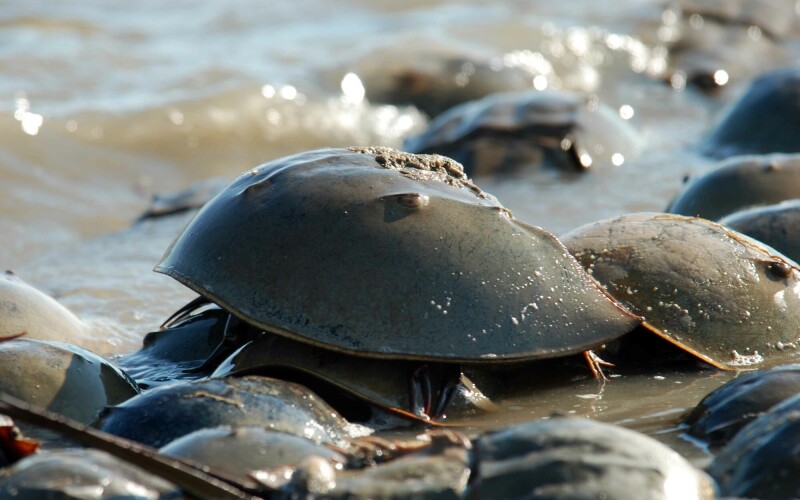A petition filed Feb. 12 with NOAA Fisheries seeks federal Endangered Species Act protection for the American horseshoe crab, a long-ubiquitous species whose populations have “crashed in recent decades because of overharvesting and habitat loss,” according to the Center for Biological Diversity.
The center and 22 other environmental groups from the Atlantic and Gulf of Mexico states want regulators to restrict horseshoe crab harvests for commercial whelk and eel fisheries, and for crab blood used by biomedical companies.
“We’re wiping out one of the world’s oldest and toughest creatures,” said Will Harlan, a senior scientist at the Center for Biological Diversity. “These living fossils urgently need Endangered Species Act protection. Horseshoe crabs have saved countless human lives, and now we should return the favor.”
Horseshoe crabs come ashore in spring along the Atlantic and Gulf coasts, laying their eggs in massive beach spawning events. One of the largest gatherings happens on Delaware Bay beaches, where the concentrations of crabs eggs attract migrating shorebirds including red knots.
But “horseshoe crab populations have declined by two-thirds in the Delaware Bay, their largest population stronghold,” according to the Center for Biological Diversity. Early alarms over declining crab and shorebird numbers led New Jersey officials to first restrict commercial crab harvests in the late 1990s.
The red knot was listed as threatened under the Endangered Species Act in 2015, when the U.S. Fish and Wildlife Service cited the horseshoe crab harvest as one of the contributing factors to the red knot’s decline.
More recently environmental groups have been at loggerheads with the Atlantic States Marine Fisheries Commission, pressing the interstate group to tighten limits on the commercial bait and biomedical harvests. The blue blood of horseshoe crabs is used to detect toxins in drugs and medical devices.
“The continued reliance on horseshoe crab blood by pharmaceutical manufacturers has led to a rapid decrease in the population of this important species,” said Kathleen Conlee, vice president for animal research issues at the Humane Society of the United States. “Fortunately, there are non-animal alternatives that can replace the use of horseshoe crab blood and help protect these amazing animals from further overharvest.”
“Horseshoe crab eggs are incredibly nutrient dense, sustaining the federally threatened red knot on their long migratory journey,” said Steve Holmer, vice president of policy at American Bird Conservancy. “Greater protection of the horseshoe crab is needed to fully recover the red knot, as well as conserve other shorebird species, such as the ruddy turnstone and semipalmated sandpiper.”
The horseshoe crab ESA petition was filed by the Center for Biological Diversity, the Humane Society of the United States and American Bird Conservancy, joined by the American Littoral Society, New Jersey Audubon, Delaware Audubon, Delaware Ornithological Society, Healthy Gulf, Humane Society Legislative Fund, League of Women Voters of New Jersey, Maryland Ornithological Society, Revive & Restore, One Hundred Miles, The Safina Center, Wild Cumberland, Forest Keeper, Coastal Expeditions Foundation, Mobile Baykeeper, Shark River Cleanup Coalition, Southeastern Massachusetts Pine Barrens Alliance, Save Coastal Wildlife, New Jersey League of Conservation Voters and the Delaware Riverkeeper Network.







